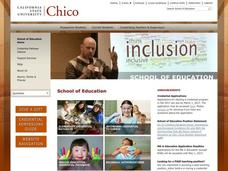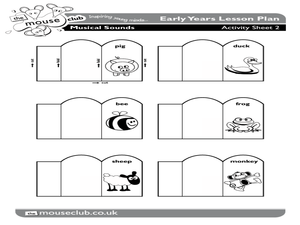Curated OER
Farm Animals-Cows, Pigs, Horses
Here is a good lesson for kindergartners that combines technology, literature, and art. In it, learners take a close look at some famous farm animals. They make the sounds that each animals makes, they use the internet to find pictures...
Michigan Reads!
Reader's Theater with Animal Masks for Preschoolers
Take a trip to the farm with a fun preschool lesson! Kids decorate animal masks and participate in a reader's theater, based on different songs and additional props.
National Gallery of Canada
Artful Emotions
Blue is sad, and red is angry, but why is that? Young artists explore the expression of emotions through art by observing and creating artwork. Starting with a questioning session about images of art, this plan moves into a sculpture...
Curated OER
Papier Mache Animals Sculptures
Fourth graders construct papier mache sculptures that emphasize texture, form and color. Each student chooses and constructs a unique papier mache sculpture of a farm animal..
Walters Art Museum
The Symbolism of Allegorical Art
Introduce learners to allegorical art with four bronze sculptures by Francesco Bertos. After modeling how to recognize bias and allegory in Bertos' Africa, class groups examine the other three sculptures in the series before creating...
Curated OER
Paper Mache Animal Sculptures
Fourth graders choose and construct farm animal paper mache sculptures. They paint their sculptures using primary colors and mixing colors, and explore various textures and forms.
Curated OER
The Hat
Honing reading and communication skills through the theme of farm animals is the focus of this lesson. Students read a book about Scandinavian farm animals and complete prediction journal activities. They complete a worksheet about the...
Curated OER
Allegory in Painting
Students examine how allegory is defined and used in the visual arts. They create a list of the arts, and list the objects, symbols, and figures that suggest each art category, analyze various paintings, and identify the allegorical...
Curated OER
Old MacDonald Had a Farm
Students complete various activities to investigate farm animals. For this farm animals lesson, students sing the song 'Old MacDonald Had a Farm,' and listen to sounds farm animals make. Students color pictures for farm animals and...
Curated OER
Musical Sounds
Students investigate music appreciation by completing worksheets. In this musical arts activity, students complete worksheets in which they identify different musical instruments, the sounds they make and the family of instruments they...
Curated OER
Allegory in Painting
Students define allegory and discuss its use in visual arts. They identify and explain allegorical themes in a number of images.
Curated OER
Allegory in Painting
High schoolers define allegory and discuss its use in the visual arts, examine paintings from various time periods and identify allegorical themes in them, and explain what makes an image allegorical.
Curated OER
My Colorful Food Chain
Students explore biology by participating in a dietary habit activity. In this food chain lesson, students discuss their own diets and the animals we feed upon daily. Students create a poster demonstrating the animals that we feed upon...
Curated OER
Kinder Poems & Songs
Students complete a year-long unit for poetry and songs. In this poetry and songs lesson, students complete nine lessons for animal songs and animal poetry to improve their understanding of rhyme, rhythm, and poetry.
Curated OER
Life on a Farm
Students take a field trip to a farm or observe pictures of farms and animals in the classroom. They paint a mural of a farm setting with animals. They practice phonetic skills with farm stories and songs. They explain how milk becomes...
Curated OER
Ani-mania
Students view and discuss Robert Harris' farm landscapes and create their own mural out of wood. In groups, they discuss various issues affecting pets throughout the world and create a way to protest or celebrate the issue. They try to...
Curated OER
Telling Time
In this telling time learning exercise, students cut out forty-two clocks, shuffle the clocks and then put them in sequential order by telling time in fifteen minute increments starting at 1:00am.
















